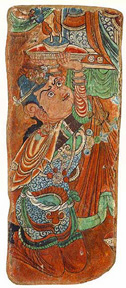
Found in Cave #9, Bezeklik, near Turfan
Xinjiang Province, China
9th century CE
Mural, ink and mineral pigments
64.2 x 56 cm
Acquisition number: #MIK III 6875
Image courtesy of the Museum für Indische Kunst (copyright reserved)
Staatliche Museen zu Berlin - Preussischer Kulturbesitz
Whether depicted as the enemies of Buddhism or as converts, representations of demons in Buddhist art serve to demonstrate the righteousness of the faith. As enemies, demons appear in such scenes as the temptation of the Buddha in the moments prior to his enlightenment, where these repulsive and evil creatures serve as stand-ins for all who would oppose the practice of the Buddhist religion. As converts, demons demonstrate both the power of the Buddha's message as well as the receptivity of the faith to all sentient creatures.
One such convert is found on this mural fragment, originally situated on the right-hand pillar of the entrance porch to Temple 9 in Bezeklik. The demon depicted crouches at the foot of an armored deity identified as Kuvera, the god of wealth1. The demon holds aloft a basin in which is placed an oil lamp with two burning wicks.
Many aspects of this figure, particularly the facial features, are rendered in a style strongly influenced by Tang-era painting. This is in contrast to the unusual manner with which the folds of the demon's shawl and sleeve are depicted, in alternating white and red bands of color. This is similar to the way in which the robes of the Buddha and monk in the "Cave at the River Bend" mural from Kizil are rendered, and may be evidence of Sassanian influence.
(1) Doitsu Torufan tankengumi: Sai'iki bijutsuten (Tokyo: Tokyo National Museum, 1991), p. 154.